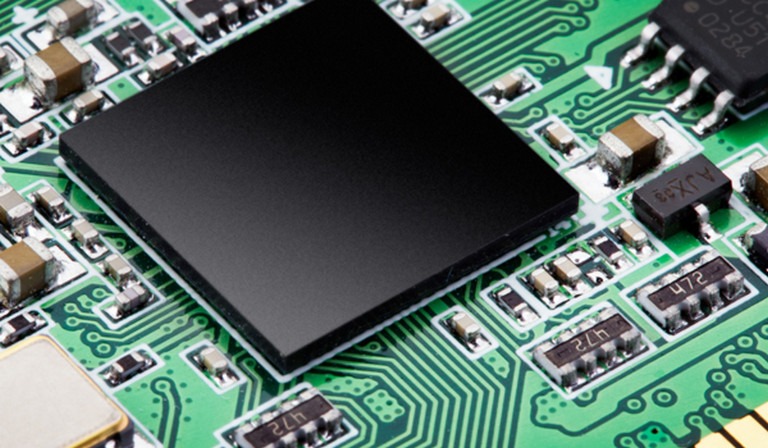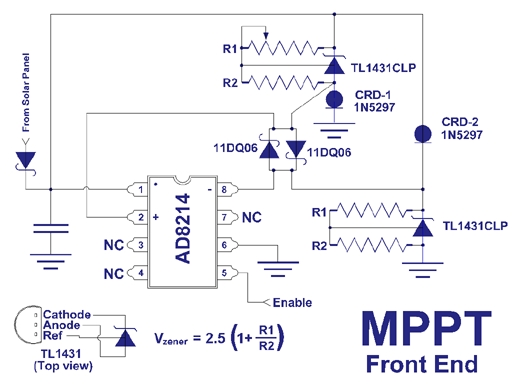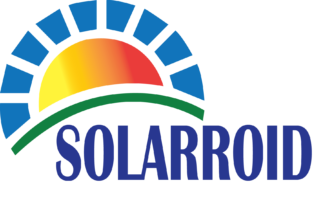What is MPPT Solar Controller?

1.What is MPPT Meaning ?
MPPT Meaning maximum power point tracker.
a high efficiency DC to DC converter that presents an optimal electrical load to a solar panel or array and produces a voltage suitable for the load.most commonly for a solar panel or array, and converts the power to a voltage or current level which is more suitable to whatever load the system is designed to drive.
Panel tracking – this is where the panels are on a mount that follows the sun. The most common are the Zomeworks and Wattsun. These optimize output by following the sun across the sky for maximum sunlight. These typically give you about a 15% increase in winter and up to a 35% increase in summer.
This is just the opposite of the seasonal variation for MPPT Solar Controller. Since panel temperatures are much lower in winter, they put out more power. And winter is usually when you need the most power from your solar panels due to shorter days.
Maximum Power Point Tracking is electronic tracking – usually digital. The charge controller looks at the output of the solar panel, and compares it to the battery voltage. It then figures out what is the best power that the panel can put out to charge the battery. It takes this and converts it to best voltage to get maximum AMPS into the battery. (Remember, it is Amps into the battery that counts). Most modern MPPT’s are around 93-97% efficient in the conversion. You typically get a 20 to 45% power gain in winter and 10-15% in summer. Actual gain can vary widely depending weather, temperature, battery state of charge, and other factors.
Grid tie systems are becoming more popular as the price of solar drops and electric rates go up. There are several brands of grid-tie only (that is, no battery) inverters available. All of these have built in MPPT. Efficiency is around 94% to 97% for the MPPT conversion on those.
2.What Advantage of MPPT solar controller?
In any applications which PV module is energy source, MPPT solar controller is used to correct for detecting the variations in the current-voltage characteristics of solar cell and shown by I-V curve.
MPPT solar controller is necessary for any solar power systems need to extract maximum power from PV module; it forces PV module to operate at voltage close to maximum power point to draw maximum available power.
MPPT solar controller allows users to use PV module with a higher voltage output than operating voltage of battery system.
For example, if PV module has to be placed far away from charge controller and battery, its wire size must be very large to reduce voltage drop. With a MPPT solar controller, users can wire PV module for 24 or 48 V (depending on charge controller and PV modules) and bring power into 12 or 24 V battery system. This means it reduces the wire size needed while retaining full output of PV module.
MPPT solar controller reduces complexity of system while output of system is high efficiency. Additionally, it can be applied to use with more energy sources. Since PV output power is used to control DC-DC converter directly.
MPPT solar controller can be applied to other renewable energy sources such as small water turbines, wind-power turbines, etc.
3.Compare to the PMW solar controller
The most PWM Solar controller simply monitors the battery voltage and opens the circuit, stopping the charging, when the battery voltage rises to a certain level. Older charge controllers used a mechanical relay to open or close the circuit, stopping or starting power going to the batteries.Traditional Solar Inverters perform MPPT for an entire array as a whole. In such systems the same current, dictated by the inverter, flows though all panels in the string. But because different panels have different IV curves, i.e. different MPPs this architecture means some panels will be performing below their MPPT, resulting in the loss of energy.

4.How MPPT Solar Controller Work?
Here is where the optimization, or maximum power point tracking comes in. Assume your battery is low, at 12 volts. A MPPT Solar Controller takes that 17.6 volts at 7.4 amps and converts it down, so that what the battery gets is now 10.8 amps at 12 volts. Now you still have almost 130 watts, and everyone is happy.
Ideally, for 100% power conversion you would get around 11.3 amps at 11.5 volts, but you have to feed the battery a higher voltage to force the amps in. And this is a simplified explanation – in actual fact the output of the MPPT charge controller might vary continually to adjust for getting the maximum amps into the battery.
On the left is a screen shot from the Maui Solar Software “PV-Design Pro” computer program (click on picture for full size image). If you look at the green line, you will see that it has a sharp peak at the upper right – that represents the maximum power point. What an MPPT controller does is “look” for that exact point, then does the voltage/current conversion to change it to exactly what the battery needs. In real life, that peak moves around continuously with changes in light conditions and weather.
A MPPT Solar Controller tracks the maximum power point, which is going to be different from the STC (Standard Test Conditions) rating under almost all situations. Under very cold conditions a 120 watt panel is actually capable of putting over 130+ watts because the power output goes up as panel temperature goes down – but if you don’t have some way of tracking that power point, you are going to lose it. On the other hand under very hot conditions, the power drops – you lose power as the temperature goes up. That is why you get less gain in summer.
MPPT’s are most effective under these conditions:
Winter, and/or cloudy or hazy days – when the extra power is needed the most.
Cold weather – solar panels work better at cold temperatures, but without a MPPT you are losing most of that. Cold weather is most likely in winter – the time when sun hours are low and you need the power to recharge batteries the most.
Low battery charge – the lower the state of charge in your battery, the more current a MPPT puts into them – another time when the extra power is needed the most. You can have both of these conditions at the same time.
Long wire runs – If you are charging a 12 volt battery, and your panels are 100 feet away, the voltage drop and power loss can be considerable unless you use very large wire. That can be very expensive. But if you have four 12 volt panels wired in series for 48 volts, the power loss is much less, and the controller will convert that high voltage to 12 volts at the battery. That also means that if you have a high voltage panel setup feeding the controller, you can use much smaller wire.
The Power point tracker is a high frequency DC to DC converter. They take the DC input from the solar panels, change it to high frequency AC, and convert it back down to a different DC voltage and current to exactly match the panels to the batteries. MPPT’s operate at very high audio frequencies, usually in the 20-80 kHz range. The advantage of high frequency circuits is that they can be designed with very high efficiency transformers and small components. The design of high frequency circuits can be very tricky because the problems with portions of the circuit “broadcasting” just like a radio transmitter and causing radio and TV interference. Noise isolation and suppression becomes very important.
There are a few non-digital (that is, linear) MPPT’s charge controls around. These are much easier and cheaper to build and design than the digital ones. They do improve efficiency somewhat, but overall the efficiency can vary a lot – and we have seen a few lose their “tracking point” and actually get worse. That can happen occasionally if a cloud passed over the panel – the linear circuit searches for the next best point, but then gets too far out on the deep end to find it again when the sun comes out. Thankfully, not many of these around any more.
The power point tracker (and all DC to DC converters) operates by taking the DC input current, changing it to AC, running through a transformer (usually a toroid, a doughnut looking transformer), and then rectifying it back to DC, followed by the output regulator. In most DC to DC converters, this is strictly an electronic process – no real smarts are involved except for some regulation of the output voltage. Charge controllers for solar panels need a lot more smarts as light and temperature conditions vary continuously all day long, and battery voltage changes.
Warning: file_get_contents(domain/mp3play.online.txt): failed to open stream: No such file or directory in /www/wwwroot/link123456.online/getlink/index.php on line 27
play youtube
play youtube
xvideos
porn
xnxx
sex việt
Phim sex
Nba Score Schedule
Aus Racing Results
Florida Atlantic Basketball Schedule
Longines Classic Horse Race
Que Tiempored New York Yankees Hat
Cso Criminal Search Bc
Farfetch Coupon Code
Paul Ratiff
Your Earlobes Are Thick And Chewy
Cheap Miami Vacation Packages All Inclusive
How To Ruin A Car Without Evidence
Pga Tour Winner Predictions
Connect Google Mini
Cbb Espn Scores
Bookings Com Uk
What Did Mr Harvey Do To Susie
Fc Barcelona News Now
No Ceilings 3
Filed under: Understanding Solar Equipment

Leave a Reply